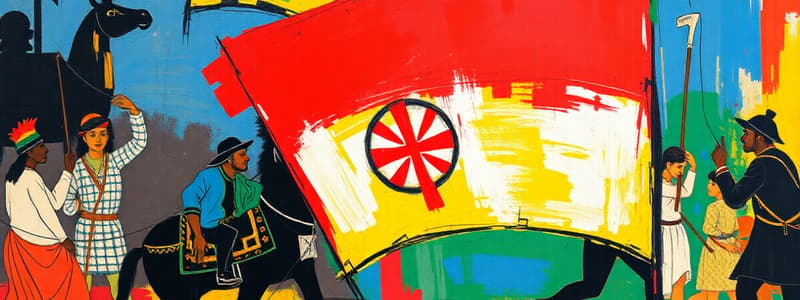Podcast
Questions and Answers
Which event most significantly marked the shift from the British East India Company's focus from trade to territorial control?
Which event most significantly marked the shift from the British East India Company's focus from trade to territorial control?
- The introduction of Western education.
- The annexation of various princely states.
- The Indian Rebellion of 1857.
- The Battle of Plassey in 1757. (correct)
What was a primary driver of the Indian Rebellion of 1857, beyond direct resistance to British rule?
What was a primary driver of the Indian Rebellion of 1857, beyond direct resistance to British rule?
- The establishment of new trade routes beneficial to Indian merchants.
- Efforts to integrate Indian society with British values peacefully.
- Desire to implement Western educational policies.
- Cultural insensitivity and economic exploitation by the British. (correct)
How did the British justify their colonial actions in India, particularly concerning the introduction of Western education?
How did the British justify their colonial actions in India, particularly concerning the introduction of Western education?
- By aiming to promote and preserve traditional Indian culture.
- By seeking to create an equal partnership between British and Indian scholars.
- By asserting a civilizing mission and the superiority of Western culture. (correct)
- By ensuring that all Indians received a comprehensive and unbiased education.
What unintended consequence arose from the British introduction of Western education in India?
What unintended consequence arose from the British introduction of Western education in India?
How were princely states incorporated into British territory?
How were princely states incorporated into British territory?
What immediate impact did the Indian Rebellion of 1857 have on the governance of India?
What immediate impact did the Indian Rebellion of 1857 have on the governance of India?
Which of the following statements best describes the economic motivations behind British expansion in India?
Which of the following statements best describes the economic motivations behind British expansion in India?
What role did key figures like Rani Lakshmibai and Bahadur Shah II play in the Indian Rebellion of 1857?
What role did key figures like Rani Lakshmibai and Bahadur Shah II play in the Indian Rebellion of 1857?
Flashcards
Trade to Territory
Trade to Territory
Shift from focusing on trade to seeking control of land in India.
Battle of Plassey
Battle of Plassey
A key turning point where the British East India Company gained political power in 1757.
Indian Rebellion of 1857
Indian Rebellion of 1857
Opposition to British rule fueled by discontent over cultural insensitivity and economic exploitation.
Rani Lakshmibai & Bahadur Shah II
Rani Lakshmibai & Bahadur Shah II
Signup and view all the flashcards
Crown Rule
Crown Rule
Signup and view all the flashcards
Civilizing Mission
Civilizing Mission
Signup and view all the flashcards
Western Education in India
Western Education in India
Signup and view all the flashcards
Rise of National Consciousness
Rise of National Consciousness
Signup and view all the flashcards
Study Notes
- Summary of bullet points from class notes and a book recommendation for further study
From Trade to Territory
- Transition from trade to territory signified a major shift in British colonial policy in India
- British East India Company initially focused on trade but began seeking territorial control
- The Battle of Plassey in 1757 allowed the Company to establish political power
- This led to increased expansion and consolidation
- Annexation of princely states through treaties and military conquests established British authority
- Chapter highlights economic motivations behind British expansion
- Sets the stage for later conflicts and resistance
When People Rebel
- Focuses on the Indian Rebellion of 1857, referred to as India's First War of Independence
- Rebellion was fueled by discontent against British policies, cultural insensitivity, and economic exploitation
- Rani Lakshmibai and Bahadur Shah II emerged during the uprising, symbolizing resistance and self-governance
- The British response was brutal, leading to socio-political changes and a shift from Company to Crown rule
- Illustrates complexities of colonial resistance and motivations for rebellion
Civilising the Nation and Educating the Native
- Explores the British justification for colonialism as a civilizing mission, emphasizing Western culture's superiority
- Western education aimed to create a class of Indians to assist in administration
- Education policies led to a rise in national consciousness, fostering identity and unity among Indians
- Key figures like Lord Macaulay played crucial roles in shaping this narrative
- Critically examines the impact of colonial education on Indian society
- This both promoted Western ideals and ignited nationalist sentiments
The Making of the National Movement
- Details the emergence of the Indian National Congress and other political organizations in the late 19th and early 20th centuries
- Discusses the shift from moderate to radical approaches in the freedom struggle
- Leaders like Bal Gangadhar Tilak and Bipin Chandra Pal gained prominence
- Highlights key events like the partition of Bengal in 1905 and the formation of the All India Muslim League
- Partition intensified nationalistic fervor
- Emphasizes role of social movements and impact of communalism on national unity
- Serves as a backdrop to understanding the fight for independence and complexities
Recommended Book for Further Study
- "India: A History" by John Keay
- A comprehensive overview of India's history during the colonial period
- Provides a detailed narrative of India's history, including the colonial era
- It offers insights into the socio-political developments of the time
Studying That Suits You
Use AI to generate personalized quizzes and flashcards to suit your learning preferences.




